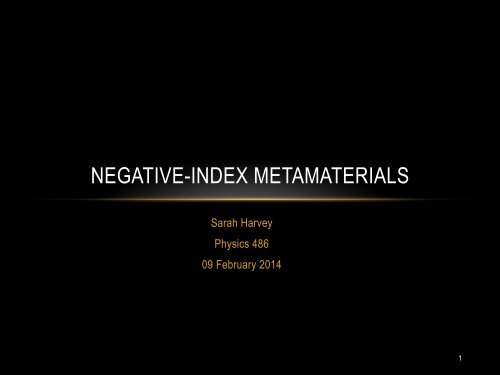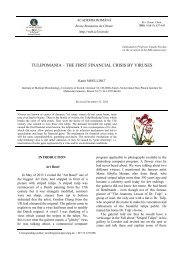NEGATIVE-INDEX METAMATERIALS
Harvey_NIM
Harvey_NIM
- No tags were found...
You also want an ePaper? Increase the reach of your titles
YUMPU automatically turns print PDFs into web optimized ePapers that Google loves.
<strong>NEGATIVE</strong>-<strong>INDEX</strong> <strong>METAMATERIALS</strong><br />
Sarah Harvey<br />
Physics 486<br />
09 February 2014<br />
1
OUTLINE<br />
• Introduction to metamaterials<br />
• Review: index of refraction<br />
• Theory of negative-index metamaterials<br />
• Real negative-index materials<br />
• Metamaterial cloaking<br />
• Problems with negative-index metamaterials<br />
2
WHAT ARE <strong>METAMATERIALS</strong>?<br />
• Man-made materials, display properties that are not<br />
found in nature<br />
• Can be designed with properties such that both the<br />
E and B components of EM radiation couple to the<br />
“meta-molecules,” enabling entirely new optical<br />
properties<br />
• Negative-index metamaterials (NIM)<br />
• Accomplished by designing microstructures smaller<br />
than the wavelength of incident radiation such that<br />
the effective result is a material that displays bizarre<br />
electromagnetic properties<br />
• The homogenization hypothesis<br />
• Effective medium theory<br />
Figure A: In a metamaterial, subwavelength<br />
engineered units replace molecules as the dominant<br />
determinant of electromagnetic properties. Figure B:<br />
An early example of a metamaterial designed to give a<br />
magnetic response at around 10GHz. Image credit:<br />
Sir John Pendry.<br />
3
REVIEW: <strong>INDEX</strong> OF REFRACTION<br />
• Dimensionless number describing how electromagnetic<br />
radiation propagates through a medium<br />
! = !<br />
! !!!"#<br />
+ !!′!!<br />
• Determines refraction of light in a material by Snell’s<br />
n = c<br />
Law:<br />
v<br />
! ! sin ! ! = ! ! ! sin ! ! !<br />
• Refractive index is related to the electric permittivity<br />
and magnetic permeability by the Maxwell relation:<br />
! ! = ! ! ! ! !<br />
Images: Wikimedia Commons<br />
4
<strong>NEGATIVE</strong> <strong>INDEX</strong> OF REFRACTION<br />
• Note: possibility of choosing the negative square root in the Maxwell relation<br />
• How can a dielectric material display a negative refractive index?<br />
• Lorentz dispersion law– can show that the permittivity (and similarly the permeability)<br />
are dependent on frequency of light in the medium<br />
Know force on electrons due to electric and magnetic fields:<br />
The electron in an atom or molecule can be assumed to be bound to the equilibrium<br />
position through an elastic restoring force<br />
Guess solution<br />
! = ! −!(! + !!×!!)!<br />
!!! + !"! + !! ! ! ! = ! −!! ! e !!!! !<br />
! = ! ! ! !!"# ! !<br />
−!! ! /!<br />
! ! = !<br />
! ! ! − !(! + !") !<br />
! ! = ! ! ! ! !<br />
5
<strong>NEGATIVE</strong> <strong>INDEX</strong> OF REFRACTION<br />
• The dipole moment due to each electron is ! = ! −!!! ,<br />
and the total dipole moment per unit volume, P, is given<br />
by the vector sum of all the dipoles in a unit volume.<br />
• If we assume one dipole per molecule and an average<br />
number density of N molecules per unit volume, we<br />
obtain<br />
! = !! =<br />
!! ! !/!<br />
! !! − !(! + !") = ! !! ! !!<br />
0.7 0.8 0.9 1.0 1.1 1.2 1.3<br />
ω/ω 0<br />
• Rearranging:<br />
! ! = 1 + ! ! ! = 1 +<br />
!! ! /!! !<br />
! ! ! − !(! + !") !<br />
LORENTZ FORMULA FOR DISPERSION<br />
0.7 0.8 0.9 1.0 1.1 1.2 1.3<br />
ω/ω 0<br />
6
<strong>NEGATIVE</strong> <strong>INDEX</strong> OF REFRACTION<br />
• So if ε and µ < 0, we find an interesting result from<br />
Maxwell’s equations in a time-harmonic plane wave in<br />
the medium:<br />
!!×!! = !! ! !!!<br />
!!×!! = ! −!! ! !!!<br />
• E, H, and k form a left handed system! BUT Poynting<br />
vector is still<br />
! = !!×!!!<br />
• If we take the relationship between S and k in terms of<br />
index of refraction:<br />
! = !!"<br />
! !<br />
• We see that the index of refraction n must be negative<br />
for this relationship to hold!<br />
Image credit: Riken Research<br />
Simulated image from Dolling et al., Optics Express<br />
2006.<br />
7
<strong>NEGATIVE</strong>-<strong>INDEX</strong> <strong>METAMATERIALS</strong><br />
• Optical properties of materials are governed by the<br />
electric permittivity ε and the magnetic permeability µ<br />
• Any collection of objects with size and spacing 0<br />
Electrical plasmas,<br />
metals, thin wire<br />
structures<br />
Double Negative<br />
Materials<br />
ε < 0, µ < 0<br />
Negative-Index<br />
metamaterials, not<br />
found in nature<br />
µ<br />
Double positive<br />
media<br />
ε > 0, µ > 0<br />
dielectrics<br />
Mu-negative<br />
materials<br />
ε > 0, µ < 0<br />
Gyromagnetic<br />
materials, magnetic<br />
plasmas?<br />
Classification of materials based on<br />
dielectric and magnetic properties<br />
ε<br />
8
REAL <strong>NEGATIVE</strong>-<strong>INDEX</strong> <strong>METAMATERIALS</strong><br />
• No naturally occurring NIM has ever been discovered!<br />
• Can combine two regions to store electrical and magnetic energy into a single cell of<br />
metamaterial<br />
• Inductor-capacitor resonance circuits<br />
• A theoretical curiosity until Smith et al experimentally demonstrated a negative refraction<br />
in the microwave using an array of copper strips and split-ring resonators in 2000<br />
9
Split-ring resonators are often used in<br />
metamaterials to induce strong<br />
magnetic coupling to the B field and<br />
provide negative µ by acting as a<br />
resonant LC circuit<br />
! ! = !1 −<br />
!! !<br />
! ! !!<br />
! ! ! − ! !!<br />
Wire mesh mimics a diluted metal and can provide<br />
negative ε with proper geometrical choices<br />
! ! = !1 −<br />
2!! !<br />
! ! ! ! ln a r<br />
!<br />
10
Split-ring resonators<br />
Wires<br />
Microwave frequency NIM<br />
Smith, D., Pendry, J., & Wiltshire, M. (2004). Metamaterials and Negative Refractive Index. Science, 305, 788-792.<br />
11
Terahertz and optical magnetic metamaterials. a) double SSR with THz response. b) staple metamaterial with mid-IR magnetic<br />
resonance. c) single SRRs with negative permeability in the IR. d) Paired silver strips with negative permeability at 725 nm.<br />
Shalaev, V. (2007). Optical negative-index metamaterials. Nature Photonics, 1, 41-48.<br />
12
APPLICATIONS OF NIM<br />
• Provides opportunities to realize physical phenomena that were previously only theoretical<br />
exercises<br />
• Improvements in magnetic resonance imaging (MRI)<br />
• Super-resolution microscopy (metamaterial lenses and superlenses)<br />
• Cloaking and transformation optics<br />
NIM flat lens (Image: Zhang et al.)<br />
13
TRANSFORMATION OPTICS AND METAMATERIAL<br />
CLOAKING<br />
• John Pendry proposed in 2006 a way of controlling electromagnetic radiation using<br />
metamaterials that could obscure objects– transformation optics was born<br />
• The mathematical technique of transformation optics shows media with gradients in<br />
optical properties are equivalent to curved geometries of spacetime for light propagation<br />
• Uses coordinate transformations to predict optical properties required for particular<br />
ray manipulations<br />
! ! !, !, ! , ! ! !, !, ! , ! ! (!, !, !)!<br />
! !! ! ! = ! !! ! !! ! ! !<br />
! !<br />
!<br />
!<br />
q 1<br />
q 2<br />
! !! ! ! = ! ! !! !! ! ! !<br />
!<br />
!<br />
!<br />
Where%i%=%1,%2,%3%and%% !<br />
%<br />
! ! ! = !"<br />
!! !<br />
!<br />
Where i = 1, 2, 3 and <br />
+ !"<br />
!! !<br />
!<br />
+ !"<br />
!! !<br />
!<br />
%<br />
14
TRANSFORMATION OPTICS AND METAMATERIAL<br />
CLOAKING<br />
• Goal: use transformation optics and metamaterials to direct EM radiation smoothly<br />
around an object to render it invisible<br />
• Fine print: object would be plunged into darkness and would not be able to see out…<br />
• Pendry et al. showed this theoretically and experimentally in 2010 but there are still<br />
many issues before perfect cloaking can be realized<br />
• Potential in digital metamaterials? (Giovampaola 2014)<br />
b<br />
a<br />
Pendry, J., Schurig, D., & Smith, D. (2006). Controlling Electromagnetic Fields. Science, 1780-1782.<br />
15
CHALLENGES WITH <strong>METAMATERIALS</strong><br />
• Metamaterials remain impractical for most applications<br />
• Broadband optical metamaterials require resonant structures<br />
~ 1 nm!<br />
• Best results attained in the microwave range<br />
• Ohmic losses to the metal resonators make metamaterials<br />
notoriously “lossy”<br />
• Problem for any device that requires high efficiency<br />
(microscopy, solar cells, cloaking)<br />
But there might still be hope…<br />
Two-dimensional cloaks. Images:<br />
WH Wee and JB Pendry<br />
16
SUMMARY AND CONCLUSION<br />
• There is no theoretical restriction on the sign of refractive index– negative indices are not<br />
observed in nature but can be fabricated using metamolecules and the homogenization<br />
hypothesis<br />
• Metamaterials research offers both opportunities to study optical systems that were once<br />
purely theoretical<br />
• Incredible applications for technology if they could be made feasible<br />
• Many hurdles before metamaterials could be seen in widespread application<br />
17
REFERENCES<br />
Capolino, F. (2009). Theory and phenomena of metamaterials. Boca Raton, FL: CRC Press/Taylor &<br />
Francis.<br />
Capolino, F. (2009). Applications of metamaterials. Boca Raton, FL: CRC Press.<br />
Engheta, N., & Ziolkowski, R. (Eds.). (2006). Metamaterials: Physics and Engineering Explorations.<br />
Piscataway, NJ: IEEE Press.<br />
Ergin, T., Stenger, N., Brenner, P., Pendry, J., & Wegener, M. (2010). Three-Dimensional Invisibility<br />
Cloak at Optical Wavelengths. Science, 337-339.<br />
Giovampaola, C., & Engheta, N. (2014). Digital metamaterials. Nature Materials, 1115-1121.<br />
Maradudin, A. (2011). Structured surfaces as optical metamaterials. Cambridge, UK: Cambridge<br />
University Press.<br />
Pendry, J., Schurig, D., & Smith, D. (2006). Controlling Electromagnetic Fields. Science, 1780-1782.<br />
Shalaev, V. (2007). Optical negative-index metamaterials. Nature Photonics, 1, 41-48.<br />
Smith, D., Pendry, J., & Wiltshire, M. (2004). Metamaterials and Negative Refractive Index. Science,<br />
305, 788-792.<br />
18
SUPER-RESOLUTION MICROSCOPY<br />
• “Superlens” first proposed by Sir John Pendry in 2000<br />
• Flat lens with focus 2d from the object<br />
• Effectively creates a region of “negative space”<br />
• Conventional diffraction limit caused by exponential<br />
decay of evanescent waves in normal materials<br />
d<br />
2d<br />
• Can show that evanescent waves exponentially<br />
enhanced through the slab, can theoretically recover all<br />
information about object at focus<br />
• Drawback: image is same size as object<br />
NIM flat lens (Image: Zhang et al.)<br />
See Griffiths Electrodynamics Problem 9.39<br />
19
Fang, N. et al. Sub-diffraction-limited optical imaging with a<br />
silver superlens. Science 308, 534–537 (2005)<br />
Scale bar: 2 µm<br />
20
Negative index metamaterials c) at λ = 2 microns and d) at λ = 1.4 microns.<br />
Shalaev, V. (2007). Optical negative-index metamaterials. Nature Photonics, 1, 41-48.<br />
21



